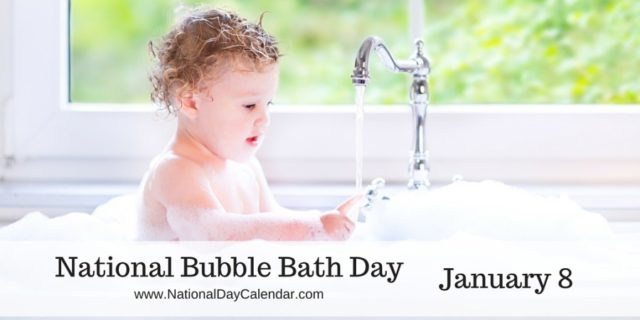
On a cold winters day, relaxing in a nice warm/hot bubble bath sounds like the perfect way to commemorate National Bubble Bath Day, which is celebrated annually on January 8th.
The bubbles on top of the water (also known as foam bath or foaming bath) insulate the bathwater, keeping it warmer for a longer period of time.
- Children find bubble baths fun and enjoy playing with the bubbles which entice them to take their baths.
- Some bubble bath, bath foam or foaming bath serves a dual purpose and can also be used as to wash skin or hair.
- Bath foam preparations may be in the form of a liquid, gel, or as solids in the form of powders, grains, or tablets.
According to the AC Nielsen Data, Mr. Bubble is the #1 brand of bath products in the United States and in 2011 it celebrated its 50th birthday. Mr. Bubble is a brand of bath product made by The Village Company.
The brand’s slogan is “Makes Getting Clean Almost as Much Fun as Getting Dirty!”
Mr. Bubble was founded by Mr. Harold Schafer and the Gold Seal Company in 1961 in North Dakota. The Gold Seal company manufactured and distributed Mr. Bubble until 1986 when the company was sold.
- People have been enjoying warm baths for thousands of years. In Ancient Rome, bathing at a public facility was part of the daily routine for most citizens. A trip to the Roman baths might include a dip in the caldarium (hot tub), a brief break in the laconicum (sauna), and a refreshing swim in the frigidarium (cold pool). Up until the late 1940s, the average American bathed once a week for personal hygiene.
– Source: Punchbowl.com - Bath houses were adopted from Middle Eastern bathing practices, and became very popular throughout the West until the late-1200’s. But water was heated by wood fires & wood became more expensive as forests were diminished. Over time, it became too expensive to maintain bath houses, and they began to go out of business. Attempts at replacing wood fuel with coal failed due to deaths from the unhealthy fumes.
- From the 1300’s on, only the very rich were able to afford firewood to heat their bath water in winter. The rest of medieval society remained unbathed for the most part, bathing an average of 3 to 4 times per year, usually around important occasions. On these rare bathing occasions, entire families would share the same bath water. Oftentimes, during low rains, extended family would be invited to share the immediate family’s bathwater, as well!
- Within medieval families, there was a bathing hierarchy for shared bath water. And though the wife prepared the bath, her Calgon dreams were soon shattered. The first to bathe, and the only member of the household to enjoy a bath in clean water, was the male head of the household — usually the husband. Next in line were subordinate male family members in order of seniority — grandfathers, uncles, brothers, sons, male cousins, etc.
- Women were always last in the familial bathing hierarchy — unless they were widowed with no male family member within the home. But women, too, followed the same hierarchical pattern: highest ranking female first — usually the wife. Then came grandmothers, aunts, sisters, daughters, female cousins, etc.
- Always last to bathe were the children. These small members of the family bathed in the filthiest bath water. From this practice, we get the expression, “Don’t throw the baby out with the bath water.”
Sources:












